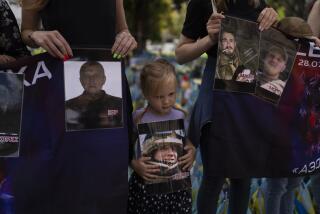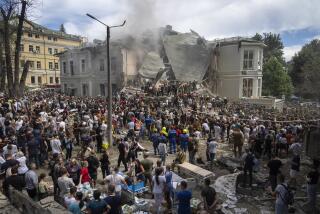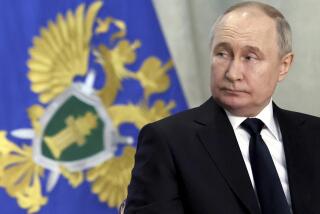Soviet Report Blames Lithuanians for Deaths in TV Station Takeover : Baltics: Prosecutor says nationalists fired fatal shots. Local officials denounce a ‘web of lies.’
MOSCOW — The Soviet Union’s chief prosecutor denied Monday that paratroopers killed any demonstrators when they stormed the Lithuanian television center in Vilnius in January, and he contended that most died as a result of Lithuanian nationalists firing into the crowd.
The 14 people who died were either shot by the Lithuanian nationalists or were deliberately pushed by other demonstrators under the oncoming tanks or the wheels of cars and trucks, prosecutor Nikolai Trubin declared in a preliminary report.
The chief prosecutor argued in the report to the Supreme Soviet, the country’s legislature, that “the tragic events in Vilnius on January 13 were the result of the Lithuanian leadership’s anti-constitutional activities.”
Lithuanian officials denounced the report as “a web of lies” intended to “put into question even the most fundamental facts” of the clash and thus salvage Soviet President Mikhail S. Gorbachev’s reputation when he receives the Nobel Peace Prize on Wednesday in Norway.
Late Monday evening, Soviet soldiers set up more than 15 checkpoints throughout Vilnius, stopping cars and pedestrians to examine their identity papers, a Lithuanian government spokesman said. No incidents were reported, but several hundred Lithuanians gathered around the Parliament building to protect it against any army assault.
Lithuanian President Vytautas Landsbergis said in a statement that Trubin, through his report, “is sacrificing himself to save Gorbachev. It seems this has been done because Gorbachev is going to Norway and will have nothing to say there.”
Gorbachev had denied any advance knowledge of the assault, saying it was a local commander’s decision, and he had ordered Trubin to investigate the cause. He has since tried to distance himself from one of the bloodiest incidents in the Soviet Union’s prolonged political and economic crisis.
“In Norway, Gorbachev will undoubtedly be confronted with the Baltics,” added Rita Dapkus of the Lithuanian parliamentary press office. “Now he can say, ‘There is conflicting information, and we are working on it.’ ”
Trubin’s report conflicts with the detailed autopsy and forensic studies done by the Lithuanian government, the eyewitness accounts of a score of foreign correspondents who saw the troops fire and the demonstrators fall, and even a photograph of a woman being crushed by a tank.
None of this was as it appeared at the time, Trubin asserted, adding that the paratroopers had fired mostly blanks and that even their live rounds were shot into the air. It was the Lithuanian nationalists who were firing from the broadcast center, television tower and nearby buildings, he said.
Thirteen civilians, including one woman, and a lieutenant from the KGB security police were killed in the predawn storming of the broadcast center. Two more men died later of their wounds, Lithuanian officials said.
According to the Trubin report, all the gunshot victims were killed by militant Lithuanian nationalists.
Trubin said they had opened fire without warning on the 380 paratroopers and 100 unidentified “volunteers” who were sent to seize the broadcast center from the Lithuanian government--which had declared independence from Moscow last year--and hand it over to a pro-Soviet “National Salvation Committee.”
“According to evidence, expert opinions and preliminary opinions of forensic experts, most of the victims died not from being shot by the military or hit by tanks,” the Trubin report said, “but from shots by the (Lithuanian nationalist) side itself, from being hit by cars and from other reasons, including those unrelated to the events.”
But Western correspondents, including John-Thor Dahlburg of The Times, reported from the scene that the demonstrators were unarmed as they attempted to protect the broadcast center through “people power.”
In Washington, State Department spokeswoman Margaret Tutwiler said the Soviet report is “at odds with the facts.”
“Videotapes and pictures taken at the time and forensic evidence developed by the Lithuanian authorities both indicate that Soviet troops were responsible for the deaths in January,” Tutwiler said. “The incident in Vilnius in January has been of great concern to us . . . and (it) certainly deserves a full, objective investigation.”
Trubin’s report acknowledged that Loreta S. Asanavichute, a garment worker, was crushed by a tank but suggested that she was the victim of Lithuanian nationalists, not the soldiers.
“Doubts have arisen in connection with the circumstances of a 24-year-old woman . . . over whose legs, judging by a photograph, tank treads passed,” the report said.
“There are numerous pieces of evidence by the military and eyewitnesses that people from the crowd were pushed under (vehicles) and pictures taken. According to witness testimony, the dead woman said before she died that she was deliberately pushed under the moving tank.”
The autopsies carried out by Lithuanian authorities found that four of the original 14 victims had been crushed by tanks or armored personnel carriers, that six had clearly died of gunshot wounds, two from “piercing wounds” probably caused by bullets, one from what appeared to be a grenade and one of a heart attack.
Altogether, 690 people were injured and 53 of those suffered bullet wounds, the Lithuanian government reported. Among the dead and most of the wounded, the bullets appeared to be from the AKMS-74 assault rifles carried by Soviet paratroopers, according to Lithuanian investigators.
Trubin said that the paratroopers, moving in tanks and armored personnel carriers, had been sent to the television tower on a hill overlooking Vilnius to “give aid to workers’ units” in breaking through the barricades and the protective ring established by nationalists around the center.
During the assault on the center, “the (Lithuanian) militants attacked the soldiers with knives, clubs and metal bars while those around the building and on the roof rained down intense fire from automatic weapons,” Trubin said.
The soldiers shot only to defend themselves, according to Trubin, and then only “directed blank fire and sometimes live ammunition bursts into the air.”
Juozas Gaudutis, who investigated the attack for the Lithuanian prosecutor’s office, called the assertions unfounded. He said Trubin’s investigators had taken part only in the autopsy of the KGB officer, Viktor Shatskikh, who had been shot in the back, and had tailored the rest of their findings to the government’s political needs.
Times staff writer Norman Kempster in Washington contributed to this article.
More to Read
Sign up for Essential California
The most important California stories and recommendations in your inbox every morning.
You may occasionally receive promotional content from the Los Angeles Times.










